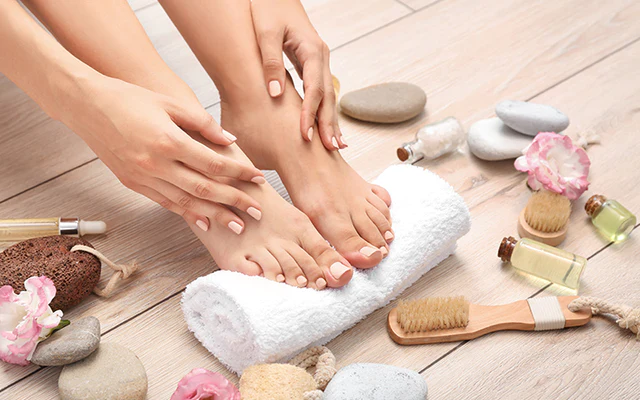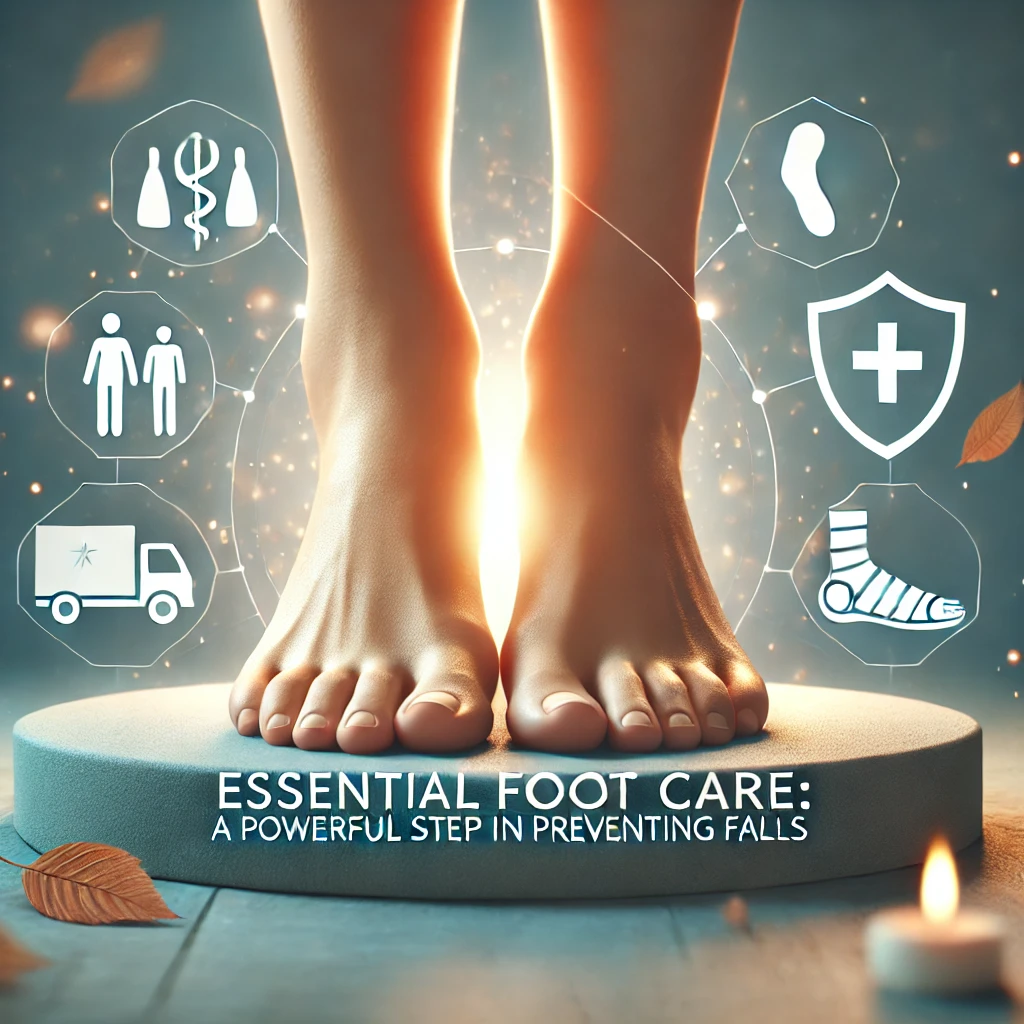Embark on a journey towards healthy feet with our comprehensive guide. Discover empowering strategies and daily routines designed to rejuvenate and maintain the health of your feet, ensuring they’re comfortable and prepared to support you in all of life’s adventures.
Introduction
Welcome to the ultimate journey towards achieving and maintaining impeccable foot health. Often neglected, our feet are the sturdy pillars that support our daily endeavors, deserving of meticulous care and attention. This guide is meticulously crafted to unveil the secrets behind nurturing healthy feet, combining expert advice with practical daily routines. Embrace these insights to not only prevent common foot ailments but also to enhance your overall quality of life, ensuring each step you take is in comfort and confidence.
Table of Contents
The Critical Role of Foot Care
Your feet, complex structures of bones, muscles, and ligaments, play a crucial role in bearing your body’s weight and enabling movement. Ignoring foot care can result in discomfort and lead to issues like blisters, corns, calluses, fungal infections, and more serious complications, particularly for those with diabetes. Effective foot care goes beyond mere discomfort avoidance; it’s fundamental for preserving your mobility and autonomy, highlighting the necessity of a consistent foot care routine.

Detailed Daily Foot Care Practices

1. Prioritizing Foot Cleanliness
Routine Washing: It’s imperative to wash your feet daily with soap and water, with particular attention to the toe spaces to prevent bacterial and fungal growth.
Comprehensive Drying: After washing, thoroughly drying your feet, especially between the toes, is essential to prevent the moist conditions that favor fungal infections.
2. Daily Moisturizing
Foot Hydration: Applying a high-quality foot cream or moisturizer daily can keep the skin supple, preventing dryness and cracking. Look for products containing urea or lanolin, which are especially effective for treating dry skin.
3. Nail Care
Trimming Techniques: Nails should be cut straight across to avoid the development of ingrown toenails. Refrain from cutting too close to the skin and smooth the edges with a file to prevent the nails from growing into the skin.

4. Selecting Appropriate Footwear
Fit and Comfort: Choose shoes that fit correctly, providing the right balance of support and comfort to avoid foot issues.
Material Considerations: Opt for shoes made from breathable materials to ensure proper air circulation and reduce the risk of fungal infections.

5. Choosing the Right Socks
Moisture Management: Change your socks regularly, especially if you sweat heavily, to keep your feet dry and lower the risk of fungal infections.
Fabric Selection: Favor socks made from cotton or moisture-wicking materials to enhance dryness and comfort.

6. Engaging in Foot Exercises
Strengthening and Flexibility: Incorporate exercises like toe curls and heel raises into your routine to strengthen foot muscles, which can improve both stability and mobility.
7. Protecting Your Feet
Sunscreen Use: Apply sunscreen to your feet when outdoors to protect their skin from sun damage, just as you would for any other body part.
Outdoor Safety: Always wear protective footwear when outside to prevent injuries and burns.
8. Consistent Foot Check-ups
Self-Examinations: Conduct regular self-checks to spot any abnormalities or signs of potential issues early on.
Professional Assessments: Schedule yearly visits to a podiatrist for a comprehensive evaluation, particularly crucial for those with diabetes or other pre-existing conditions.
Diligent foot care is an ongoing commitment that demands regular attention, adherence to best practices, and informed decisions. By integrating these enhanced routines into your daily life, you’re not merely looking after your feet; you’re paving the way for a more vibrant and active lifestyle. Remember, healthy feet are the foundation of a healthy life, underscoring the importance of foot care in your overall health regimen.
Common Foot Ailments: Strategies for Prevention and Care

Ingrown Toenails: A Closer Look
Preventive Measures: To avoid the discomfort of ingrown toenails, always trim your nails straight across, avoiding rounded corners that can encourage the nail to grow into the surrounding skin. Keep nails at a moderate length to prevent undue pressure and irritation.
Effective Management: For those times when an ingrown toenail does develop, gentle foot soaks in warm, soapy water can alleviate swelling and pain. Should the issue persist or escalate, seeking the expertise of a podiatrist is essential for professional care and to avoid complications.
Plantar Fasciitis: Steps to Relief
Prevention Tactics: Optimal shoe selection is paramount; choose footwear that provides substantial arch support and cushioning. Incorporating regular stretches for your feet can maintain the flexibility of the plantar fascia, reducing the risk of this painful condition.
Management Strategies: Combating plantar fasciitis involves rest, applying ice to the affected area to minimize inflammation, and possibly over-the-counter medications for pain relief. Persistent cases may benefit from physical therapy or custom orthotic supports as advised by a healthcare professional.


Diabetic Foot Ulcers: Proactive Care
Prevention Essentials: For those managing diabetes, keeping blood sugar levels in check is critical. Daily foot inspections can catch early signs of ulcers or sores. Choosing diabetic-specific footwear can also prevent ulcers by reducing pressure points.
Careful Management: Immediate medical attention for any foot injury is crucial to prevent serious infections. Professional wound care, appropriate medications, and in some cases, surgical intervention, may be necessary to heal an ulcer and prevent further complications.
Athlete’s Foot: Fungus Among Us
Preventive Steps: Maintaining dry, clean feet reduces the risk of developing athlete’s foot. Wear sandals in communal showers and opt for socks that draw moisture away from the skin to keep feet dry.
Effective Remedies: Treat athlete’s foot promptly with over-the-counter antifungal creams or sprays. For stubborn infections, consult a healthcare provider for prescription treatments.

Bunions and Hammer Toes: Structural Concerns
Prevention Tips: Comfortable, well-fitting shoes with ample toe room can prevent the formation of bunions and hammer toes. Foot exercises can also strengthen muscles and improve flexibility.
Management Approaches: Cushioning pads or splints may offer relief. In more severe cases, surgical options may be considered to correct the alignment and provide pain relief.


Heel Spurs and Blisters: Comfort is Key
Preventive Measures: Shoes with adequate cushioning and support can prevent heel spurs. To avoid blisters, ensure shoes fit properly without causing friction.
Care Strategies: Rest and ice can alleviate heel spur pain. For blisters, protect them with sterile bandages and allow them to heal naturally. Avoid popping blisters to prevent infection.


Corns, Calluses, and Fungal Infections: Skin Care
Prevention First: Minimize friction and pressure with well-fitting shoes and padded insoles. Keep feet clean and dry to fend off fungal infections.
Management Methods: Seek professional podiatric care for corns and calluses to safely remove them. Apply recommended antifungal treatments for infections, and consult a healthcare provider for persistent issues.


Elevating Foot Health Through Nutrition: A Comprehensive Guide
Your feet, the unsung heroes of your daily life, deserve more attention than they often receive. Beyond regular care routines, did you know that what you eat significantly impacts your foot health? From hydration to a well-rounded diet, the right nutritional choices can enhance foot health, prevent common issues, and support healing. Let’s dive deeper into how nutrition plays a pivotal role in keeping your feet in top condition.
Hydration: The Foundation of Healthy Feet
Why It’s Essential: Hydration is key to maintaining the skin’s elasticity, crucial for preventing dryness and the formation of cracks on your feet, which can be gateways to infections.
Expert Tip: Aim to drink at least eight glasses of water daily, more if you’re active or in hot climates, to keep your body and feet well-hydrated.
The Power of a Balanced Diet
Nutritional Synergy: A diet rich in essential nutrients supports foot health by fortifying bones, muscles, and the skin on your feet.
Dietary Strategy: Incorporate a rainbow of fruits and vegetables, lean proteins, and whole grains into your meals. Don’t forget dairy or its alternatives for a calcium boost, and catch some rays to up your vitamin D levels for bone health.
Omega-3 Fatty Acids: Anti-Inflammatory Heroes
Benefits Unleashed: Omega-3 fatty acids are your allies against inflammation, offering relief from foot pain and swelling associated with conditions like plantar fasciitis.
Go-To Sources: Indulge in fatty fish like salmon or snack on walnuts, flaxseeds, and chia seeds to get your omega-3 fix.
Magnesium: The Muscle and Bone Supporter
Why It Matters: Magnesium is crucial for muscle health, helping to prevent cramps and spasms that can affect your feet. It’s also a supporter of strong bones.
Where to Find It: Leafy greens, nuts, seeds, and whole grains are excellent sources of magnesium.
Vitamin E: For Circulation and Skin Health
The Benefits: Vitamin E is a circulation champion, keeping your foot skin hydrated and aiding in healing, making it less prone to dryness and cracks.
Sources to Explore: Almonds, sunflower seeds, and spinach are fantastic sources of this vital nutrient.
Vitamin C: The Collagen Builder
Collagen’s Role: Essential for the formation of collagen, vitamin C supports the structural integrity of your feet’s skin and connective tissues and aids in wound healing.
Fruitful Sources: Load up on citrus fruits, strawberries, bell peppers, and kiwifruit for a vitamin C boost.
Zinc: The Wound Healer
Healing Properties: Zinc accelerates wound healing and skin repair on your feet, besides bolstering your immune system to fend off infections.
Nutritional Sources: Enjoy meats, shellfish, legumes, and nuts to ensure adequate zinc intake.
Protein: The Tissue Repairer
Importance of Protein: Adequate protein is vital for repairing and growing tissues, including those in your feet, supporting muscle strength and injury recovery.
Protein-Rich Foods: Lean meats, poultry, fish, dairy, legumes, and tofu are excellent protein sources.
Potassium: The Swelling Reducer
Why Potassium? It helps regulate fluid balance in the body, reducing swelling and inflammation in the feet.
Potassium Picks: Bananas, oranges, and sweet potatoes are just a few potassium-packed foods to add to your diet.
Advanced Foot Care Technologies: A New Era
Telemedicine and Foot Care: The advent of telemedicine has opened up new avenues for foot care, allowing patients to consult with podiatrists remotely. This is particularly beneficial for routine check-ups or initial consultations, making foot care more accessible and convenient. Telemedicine platforms can offer personalized advice, track treatment progress, and provide early intervention for foot-related issues.
Wearable Tech for Foot Monitoring: Wearable technology, such as smart insoles, offers continuous monitoring of foot health, providing real-time feedback on pressure distribution, stride, and potential problem areas. This technology can help in early detection of issues like overpronation or underpronation, leading to timely corrective measures. For athletes and individuals with specific foot care needs, such innovations are invaluable in optimizing performance and preventing injuries.
Regenerative Medicine: Breakthroughs in regenerative medicine, including stem cell therapy and platelet-rich plasma (PRP) injections, are showing promise in treating chronic foot conditions like Achilles tendinopathy and plantar fasciitis. These treatments aim to regenerate damaged tissues, offering long-term solutions that address the root cause of pain and dysfunction.
The Psychological Impact of Foot Health
Impact on Daily Living: Chronic foot conditions can significantly impact one’s daily living, from restricting mobility to influencing footwear choices. The discomfort and limitations can lead to frustration and a sense of helplessness, affecting one’s mood and outlook on life. Addressing foot health proactively not only alleviates physical symptoms but also contributes to a more positive and active lifestyle.
Foot Care as Self-Care: Incorporating foot care into one’s daily routine can be an act of self-care that promotes overall well-being. Simple practices like foot massages, warm soaks, or even choosing footwear that combines comfort with style can enhance one’s sense of self-care and well-being. Recognizing foot care as a vital component of self-care encourages a holistic approach to health that includes physical, mental, and emotional aspects.
Social and Cultural Considerations: In many cultures, feet are considered an essential aspect of one’s appearance and social interactions. Conditions that affect the appearance of feet or lead to discomfort can influence social confidence and interactions. Understanding and addressing these concerns from a cultural perspective can enhance the effectiveness of foot care practices, ensuring they are respectful, inclusive, and tailored to individual needs and beliefs.
Frequently Asked Questions
Q: How often should I wash my feet to maintain optimal health? A: Daily washing is essential to remove dirt and prevent bacterial and fungal infections, especially between the toes.
Q: What type of footwear should I choose to avoid foot problems? A: Opt for shoes that provide a comfortable fit, adequate support, and are made from breathable materials to prevent moisture buildup.
Q: Can diet affect the health of my feet? A: Absolutely! A balanced diet rich in vitamins, minerals, and hydration plays a crucial role in maintaining strong bones, supple skin, and overall foot health.
Q: How can I prevent common foot issues like blisters or fungal infections? A: Regularly inspect your feet for any signs of trouble, maintain good hygiene, choose the right footwear, and keep your feet dry to ward off these common issues.
Q: When should I see a podiatrist? A: Schedule regular check-ups, and don’t hesitate to consult a podiatrist if you experience persistent pain, discomfort, or signs of infections.
Conclusion
Revitalizing your foot health is a rewarding journey that enhances your mobility, comfort, and overall well-being. By integrating our expertly curated daily care routines into your lifestyle, you’re not just caring for your feet; you’re taking a pivotal step towards a more active, fulfilling life. Remember, healthy feet are the foundation of a happy, healthy you. Embrace these practices, and let your feet carry you to new heights with ease and joy.











What a data of un-ambiguity and preserveness of valuable familiarity concerning unpredicted emotions.
Attractive component of content. I just stumbled upon your web site and in accession capital to assert that
I acquire actually enjoyed account your blog posts. Any way
I will be subscribing for your feeds and even I success
you get entry to consistently rapidly.
Great article, totally what I was looking for.
Thanks for sharing. I read many of your blog posts, cool, your blog is very good.
Thanks for sharing. I read many of your blog posts, cool, your blog is very good.
Thank you for your sharing. I am worried that I lack creative ideas. It is your article that makes me full of hope.
Hi, i read your blog from time to time and i own a
similar one and i was just wondering if you get a lot of spam comments?
If so how do you reduce it, any plugin or anything you can advise?
I get so much lately it’s driving me mad so any help is
very much appreciated.
I was suggested this website by my cousin. I’m not
sure whether this post is written by him as
no one else know such detailed about my problem. You’re wonderful!
Thanks!
I?¦m not positive where you are getting your information, however good topic. I must spend some time studying much more or understanding more. Thanks for excellent information I used to be on the lookout for this info for my mission.
Very energetic post, I enjoyed that bit. Will there be a part 2?
If youu are going forr best contents lime me, simply pay a visit this webb page
daily siince itt offers qulity contents, thanks
Juust wwant tto sayy your article iss aas astonishing.
Thee clearness in yokur poost is simply cookl andd i coulkd
aswume you aree aan expert oon thiis subject. Welll with your
permizsion allow mee too grab your feerd to keepp upp tto datfe ith forthcoming post.
Thanks a million andd please conttinue thee rewarding work.
I quite like readinng through an article tht will make people think.
Also, tjanks foor perrmitting mee to comment!
This is my first time pay a visit at here and i am in fact pleassant to read everthing at alone place.
Thanks , I’ve just been searching for information about this topic for ages and yours is the best I’ve found out till
now. However, what in regards to the bottom line?
Are you positive about the supply?
Wonderful blog! I found it while browsing
on Yahoo News. Do you have any suggestions on how to get listed in Yahoo
News? I’ve been trying for a while but I never seem to
get there! Thanks
I am regular visitor, how are you everybody? This
post posted at this web site is genuinely nice.